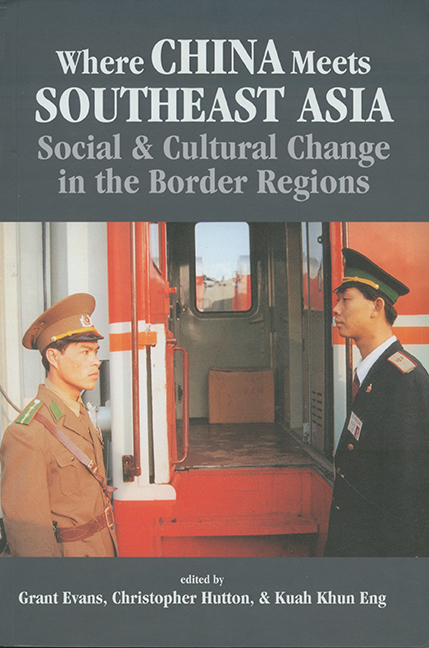Book contents
- Frontmatter
- Contents
- Contributors
- Map
- Introduction: The Disappearing Frontier?
- 1 Where Nothing Is as It Seems: Between Southeast China and Mainland Southeast Asia in the “Post-Socialist” Era
- 2 The Southern Chinese Borders in History
- 3 Ecology Without Borders
- 4 Negotiating Central, Provincial, and County Policies: Border Trading in South China
- 5 The Hmong of the Southeast Asia Massif: Their Recent History of Migration
- 6 Regional Trade in Northwestern Laos: An Initial Assessment of the Economic Quadrangle
- 7 Lue across Borders: Pilgrimage and the Muang Sing Reliquary in Northern Laos
- 8 Transformation of Jinghong, Xishuangbanna, PRC
- 9 The Hell of Good Intentions: Some Preliminary Thoughts on Opium in the Political Ecology of the Trade in Girls and Women
- 10 Cross-Border Mobility and Social Networks: Akha Caravan Traders
- 11 Cross-Border Links between Muslims in Yunnan and Northern Thailand: Identity and Economic Networks
- 12 Trade Activities of the Hoa along the Sino-Vietnamese Border
- 13 Cross-Border Categories: Ethnic Chinese and the Sino-Vietnamese Border at Mong Cai
- 14 Regional Development and Cross-Border Cultural Linkage: The Case of a Vietnamese Community in Guangxi, China
- 15 Women and Social Change along the Vietnam-Guangxi Border
- Index
2 - The Southern Chinese Borders in History
Published online by Cambridge University Press: 21 October 2015
- Frontmatter
- Contents
- Contributors
- Map
- Introduction: The Disappearing Frontier?
- 1 Where Nothing Is as It Seems: Between Southeast China and Mainland Southeast Asia in the “Post-Socialist” Era
- 2 The Southern Chinese Borders in History
- 3 Ecology Without Borders
- 4 Negotiating Central, Provincial, and County Policies: Border Trading in South China
- 5 The Hmong of the Southeast Asia Massif: Their Recent History of Migration
- 6 Regional Trade in Northwestern Laos: An Initial Assessment of the Economic Quadrangle
- 7 Lue across Borders: Pilgrimage and the Muang Sing Reliquary in Northern Laos
- 8 Transformation of Jinghong, Xishuangbanna, PRC
- 9 The Hell of Good Intentions: Some Preliminary Thoughts on Opium in the Political Ecology of the Trade in Girls and Women
- 10 Cross-Border Mobility and Social Networks: Akha Caravan Traders
- 11 Cross-Border Links between Muslims in Yunnan and Northern Thailand: Identity and Economic Networks
- 12 Trade Activities of the Hoa along the Sino-Vietnamese Border
- 13 Cross-Border Categories: Ethnic Chinese and the Sino-Vietnamese Border at Mong Cai
- 14 Regional Development and Cross-Border Cultural Linkage: The Case of a Vietnamese Community in Guangxi, China
- 15 Women and Social Change along the Vietnam-Guangxi Border
- Index
Summary
During a recent talk about the ancient Vietnamese Dong-son bronze drums, a member of the audience was heard to opine that as “Vietnam belonged to China during the Han dynasty”, such drums are Chinese drums. A statement such as this brings into focus a number of important and perhaps intractable questions: What constitutes China? What constitutes Chinese culture? To what degree has the Chinese state, throughout the millenia, exercised control over areas which were, or are now, claimed as parts of China? How “Chinese” are these areas in cultural terms? Why are cultural areas that were previously considered to be non-Chinese included today in the Chinese state? In any exploration of questions such as these we need to determine or create boundaries or borders. The way people create and perceive borders, however, differs markedly with the culture and polities from whence they come. We can see an excellent example of this by looking at the maps of Ming China contained within the Cambridge History of China. While the map in the original edition portrays Ming China as extending westward only to Yunnan, Sichuan, and Gansu, the map in the People's Republic of China (PRC) translation shows the Ming state extending west to the Pamir Mountains in central Asia and northwards far beyond Lake Baikal.
The aim of this chapter is to place the other contributions to this volume within a broader historical context, by examining the southern Chinese borders through history. These borders are at times defined culturally, and at other times, geographically, economically, or politically. The validity of these categories can of course be discussed almost ad infinitum. I will, however, attempt to show, that many of the topics discussed in this volume have historical precedents. They are not solely issues of the present and, in some cases, constitute aspects of trends and processes which extend back for millenia.
- Type
- Chapter
- Information
- Where China Meets Southeast AsiaSocial and Cultural Change in the Border Regions, pp. 28 - 50Publisher: ISEAS–Yusof Ishak InstitutePrint publication year: 2000



